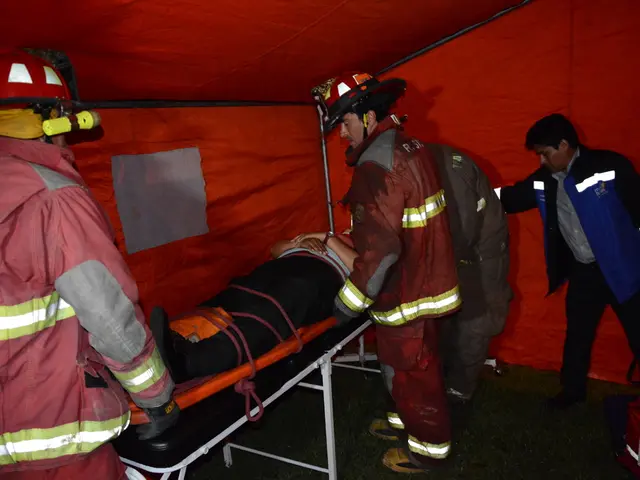Distinguishing Age Spots from Skin Cancer: Recognizing the Differences
Harmless Age Spots vs. Potentially Harmful Skin Cancer: Identifying the Differences
As individuals age, they may develop skin lesions that resemble cancerous growths. However, these marks may not always be concerning—these are age spots. Understanding the differences between age spots and skin cancer can help in identifying when medical attention is necessary.
Age spots, also known as solar lentigines or liver spots, are harmless and don't require treatment. These dark patches appear on the skin due to increased melanin production, triggered by sun exposure. Age spots have a flat, smooth texture and are generally a yellow, brown, or gray color with clear borders. They typically develop on parts of the body that are exposed to the sun, such as the face, hands, and shoulders. Age spots usually appear in middle age and are more common on fair skin, but they can appear on skin of any color.
Skin cancer, on the other hand, is a malignant condition that can spread throughout the body if left untreated. Like age spots, skin cancer is more likely to occur on sun-exposed areas. This happens due to damage caused by UV radiation from the sun or tanning beds. Skin cancer develops when skin cells are harmed and start to grow and spread at an accelerated rate. The three most common types of skin cancer are basal cell carcinoma, squamous cell carcinoma, and melanoma.
Actinic keratosis is another type of growth that can be mistaken for an age spot. This precancerous condition appears due to UV radiation damage and, if left untreated, can develop into squamous cell carcinoma. Therefore, it's crucial to keep a close watch on any changes in the skin and consult a healthcare professional if symptoms of skin cancer or actinic keratosis appear.
Skin cancer symptoms can vary depending on factors like the type of cancer and an individual's skin type. Some signs that a growth might be cancerous include asymmetry, irregular edges, changing size, color, or shape, multiple colors on the same spot, and pain, itching, oozing, or bleeding. If a mark on the skin changes in color, shape, size, or location, appears different from other marks, itches, crusts, scabs over, or doesn't heal within four weeks, it's essential to seek medical advice promptly.
In order to diagnose age spots, doctors and dermatologists examine the spots visually, assessing their appearance, texture, and placement. If they are unsure of the diagnosis, they may perform a skin biopsy to test for other conditions like skin cancer or actinic keratosis. Age spots cannot turn into cancer.
Treatment options vary depending on whether the growth is an age spot or skin cancer. Age spots do not require treatment as they are benign, but some people may choose to have them removed for cosmetic reasons. Possible treatments include creams, lotions, laser treatments, cryosurgery, microdermabrasion, and chemical peeling.
Skin cancer treatment depends on factors such as the type, stage, and location of the cancer. Surgical removal is often the preferred method for basal and squamous cell cancers, but if the position makes surgical treatment difficult, other options like topical therapies, radiation therapy, chemotherapy, immunotherapy, or systemic medication may be considered. For actinic keratosis, treatment options include topical creams, cryotherapy, or photodynamic therapy.
Prompt medical attention can help in early detection of skin cancer, making treatment easier and improving health outcomes. Regular skin self-examinations and yearly skin checks with a dermatologist are recommended for people with a higher risk of skin cancer due to factors like fair skin, a history of sunburn, multiple moles, a family history of skin cancer, or a weakened immune system.
In summary, identifying age spots, skin cancer, and actinic keratosis can help individuals protect their skin's health. Age spots are harmless, while skin cancer can be potentially dangerous if left untreated. Regular self-examinations, continued education, and seeking medical advice when suspicious changes occur can help ensure skin health and wellbeing.
- Dermatology plays a crucial role in distinguishing between harmless age spots and potentially harmful skin cancer, ensuring prompt treatment when necessary.
- Cancer specialists, or oncologists, may be involved in the treatment of more advanced or aggressive forms of skin cancer, such as melanoma.
- Seniors, particularly those with fair skin and a history of excessive sun exposure, should pay close attention to their skin-care routine and medical-conditions, including skin-conditions that might indicate the presence of skin cancer or other skin abnormalities.
- Science continues to advance our understanding of skin conditions, leading to better skin-care practices and more effective treatments for both benign age spots and skin cancer.
- In the realm of health-and-wellness, maintaining good skin health involves more than just skin-care products; it also entails regular self-examinations and professional dermatology check-ups to identify and address any concerning skin changes.








